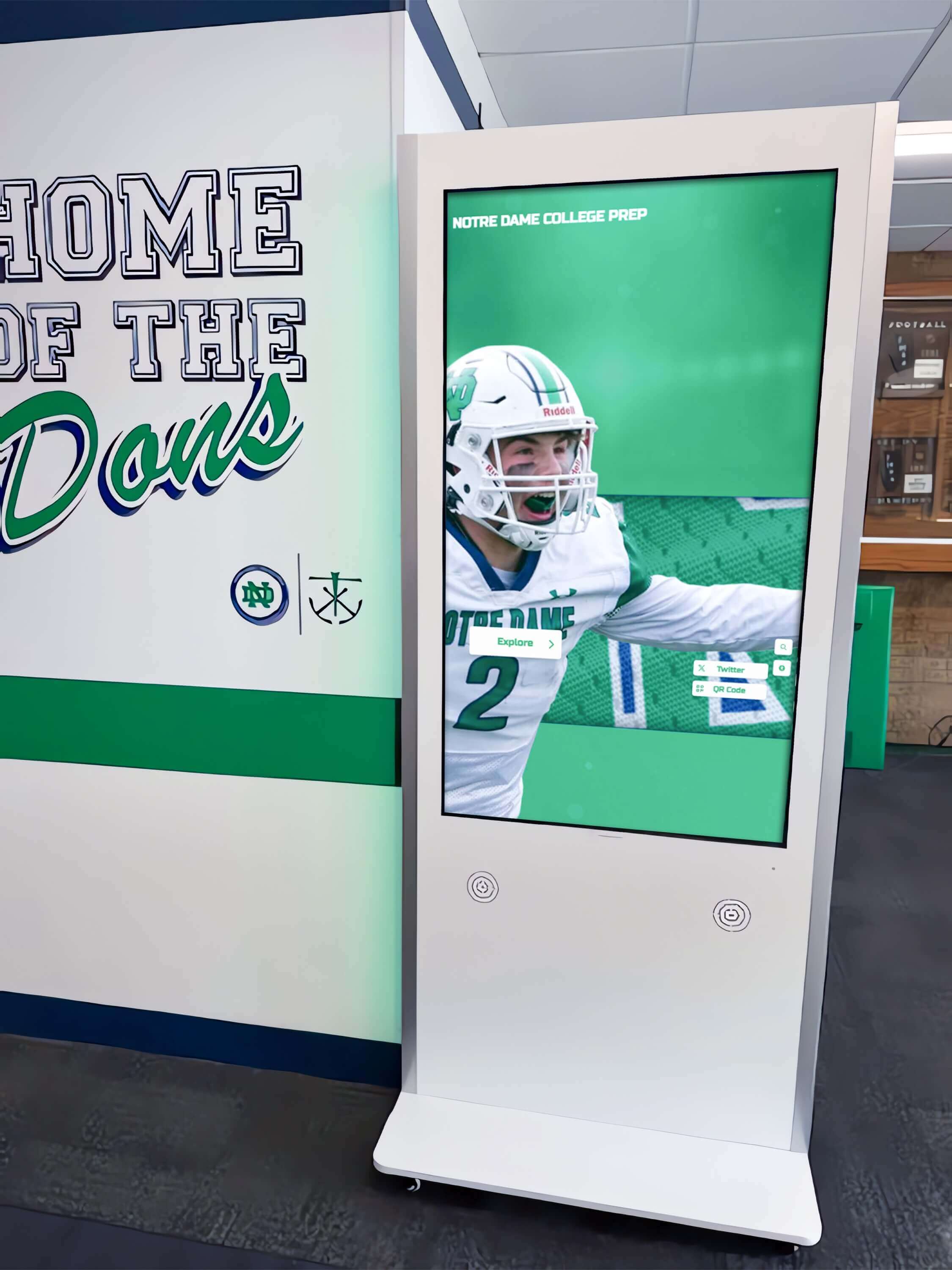Schools face an increasingly complex challenge in 2026: how to honor decades of student achievement, athletic excellence, and institutional history when physical space remains finite and community expectations continue to evolve. Traditional trophy cases overflow with plaques that barely anyone reads. Championship banners crowd gymnasiums until they obscure rather than celebrate success. Countless achievements sit forgotten in storage rooms, providing zero inspirational value to current students or meaningful connection for alumni.
Digital hall of fame software solves these fundamental limitations while transforming how educational institutions recognize achievement, preserve history, and engage their communities. These specialized platforms provide unlimited recognition capacity, rich multimedia storytelling, instant content updates, powerful search capabilities, and web accessibility—features that physical displays simply cannot match.
This comprehensive guide examines the eight best digital hall of fame software solutions available to schools in 2026. You’ll discover essential features that distinguish exceptional platforms from disappointing alternatives, understand realistic cost structures and implementation timelines, explore how leading institutions maximize their recognition investments, and learn exactly which solution best fits your school’s specific needs and budget.
Whether you’re replacing overcrowded trophy cases, launching your first digital recognition initiative, or expanding existing systems to better serve your community, this guide provides the insights needed to make informed decisions that will serve your school for decades to come.
Understanding Digital Hall of Fame Software vs. Generic Digital Signage
Not all digital displays serve recognition needs equally well. The distinction between purpose-built digital hall of fame software and generic digital signage platforms determines whether your investment delivers transformative results or disappointing mediocrity.
What Makes Hall of Fame Software Special?
Digital hall of fame software represents specialized platforms designed specifically for celebrating and showcasing achievements across athletics, academics, arts, alumni success, and institutional history. These systems focus on recognition, engagement, discovery, and historical preservation rather than simple content broadcasting.
Core Recognition Capabilities:
- Searchable databases enabling visitors to find specific individuals or achievements instantly
- Comprehensive profile systems supporting detailed biographies, statistics, career timelines, and accomplishments
- Organized category structures by sport, year, achievement type, department, or custom groupings
- Interactive navigation allowing users to explore connections between related achievements
- Multimedia integration showcasing photos, videos, audio interviews, documents, and historical artifacts
- Web-accessible interfaces enabling alumni anywhere to explore their recognition remotely
- Analytics tracking engagement patterns, popular content, and usage metrics
Purpose-built hall of fame software anticipates how schools think about recognition, providing templates, workflows, and features specifically designed for celebrating student achievement and institutional excellence.
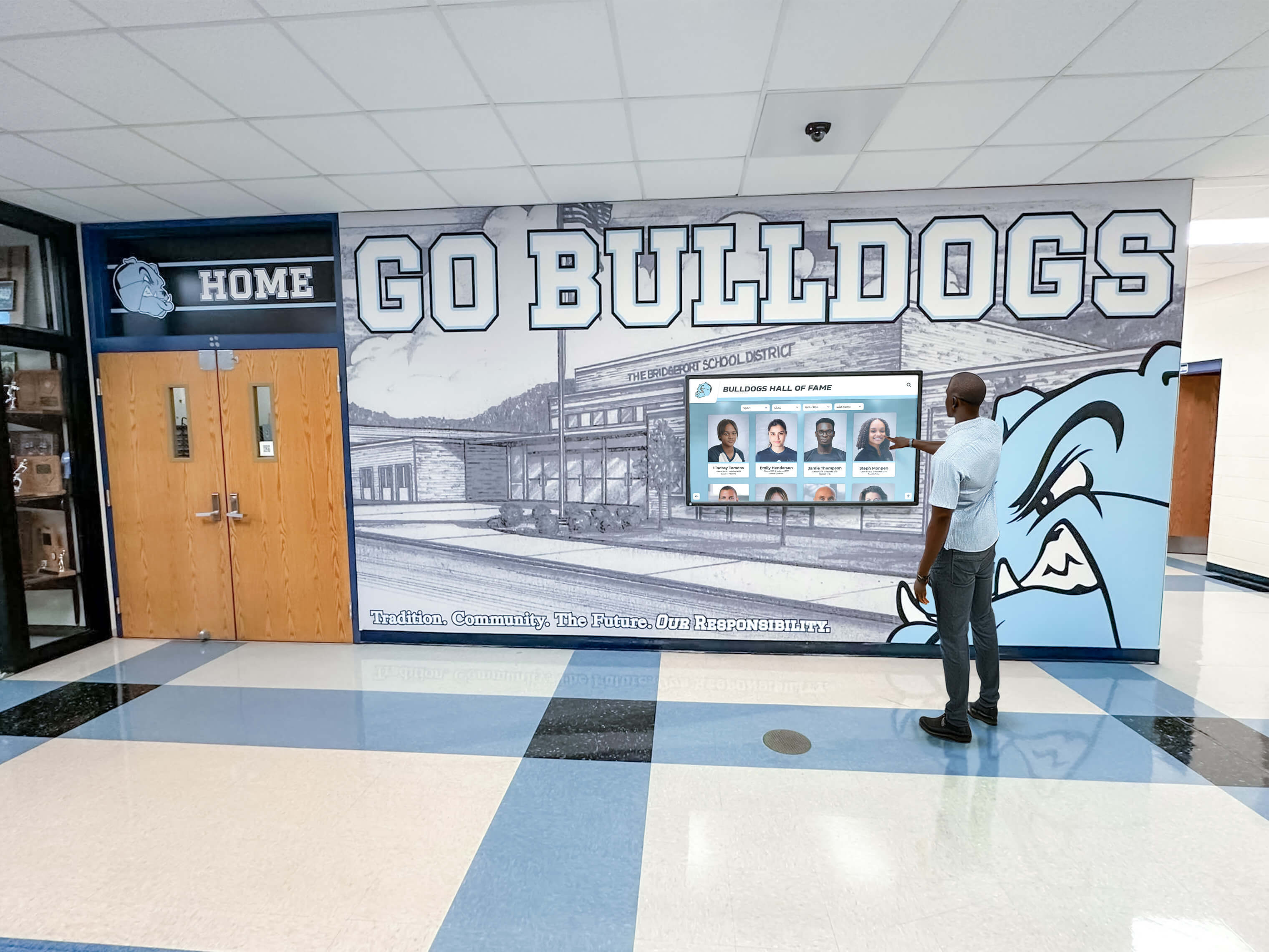
The Generic Digital Signage Trap
Generic digital signage platforms excel at broadcasting announcements, schedules, menus, and promotional content. These systems prioritize content distribution and scheduling rather than interactivity, deep database functionality, or recognition-specific features.
Schools attempting to adapt general digital signage for recognition purposes typically encounter severe limitations: nonexistent or rudimentary search functionality, shallow content organization lacking relational database structure, poor user experiences frustrating visitors seeking specific information, and no web accessibility for remote alumni engagement.
The most successful recognition implementations use purpose-built hall of fame software even when considering multi-purpose displays, as specialized platforms deliver dramatically superior experiences for achievement celebration while often offering adequate digital signage capabilities for secondary applications.
Essential Features Every Quality Hall of Fame Platform Must Provide
Understanding critical capabilities helps schools identify solutions that deliver long-term success versus those that disappoint after initial enthusiasm fades.
1. Intuitive Content Management for Non-Technical Staff
The best hall of fame software recognizes that athletic directors, activities coordinators, alumni office staff, and administrators managing content typically lack technical backgrounds. Exceptional platforms require no programming knowledge, coding experience, or IT support for routine updates.
Must-Have Content Management Features:
- Web-based dashboards accessible from any internet-connected device
- Drag-and-drop interfaces for organizing content and uploading media
- Bulk import tools handling roster data and historical records efficiently
- Pre-built templates for common recognition types (sports, academics, arts, service, alumni)
- Preview capabilities showing exactly how content displays before publishing
- Role-based permissions enabling distributed content management across departments
- Revision history tracking changes and supporting content recovery
- Mobile-responsive management interfaces for updates from smartphones or tablets
Schools implementing systems requiring professional developers for updates inevitably struggle with stale content as staff lack confidence or capability to maintain displays independently.
2. Powerful Search and Discovery Tools
Recognition value depends entirely on discoverability. Systems must enable visitors to find specific achievements quickly through multiple pathways rather than requiring chronological browsing through potentially thousands of profiles.
Critical Search Capabilities:
- Full-text search across names, teams, years, achievements, and biographical information
- Smart filters by sport, decade, achievement type, category, or custom attributes
- Autocomplete suggestions helping users find content quickly as they type
- Related content recommendations showing connections between achievements, teammates, or eras
- Popular content highlighting frequently viewed profiles and trending honorees
- Bookmarking allowing users to save favorite profiles for later viewing
- QR code generation enabling smartphone access to specific profiles from physical displays
Interactive experiences transform casual viewers into active explorers through intuitive search and navigation. Students spend 5-10 minutes discovering connections between their families’ achievements, coaches’ legacies, and school history—engagement impossible with static physical displays or poorly designed digital alternatives.
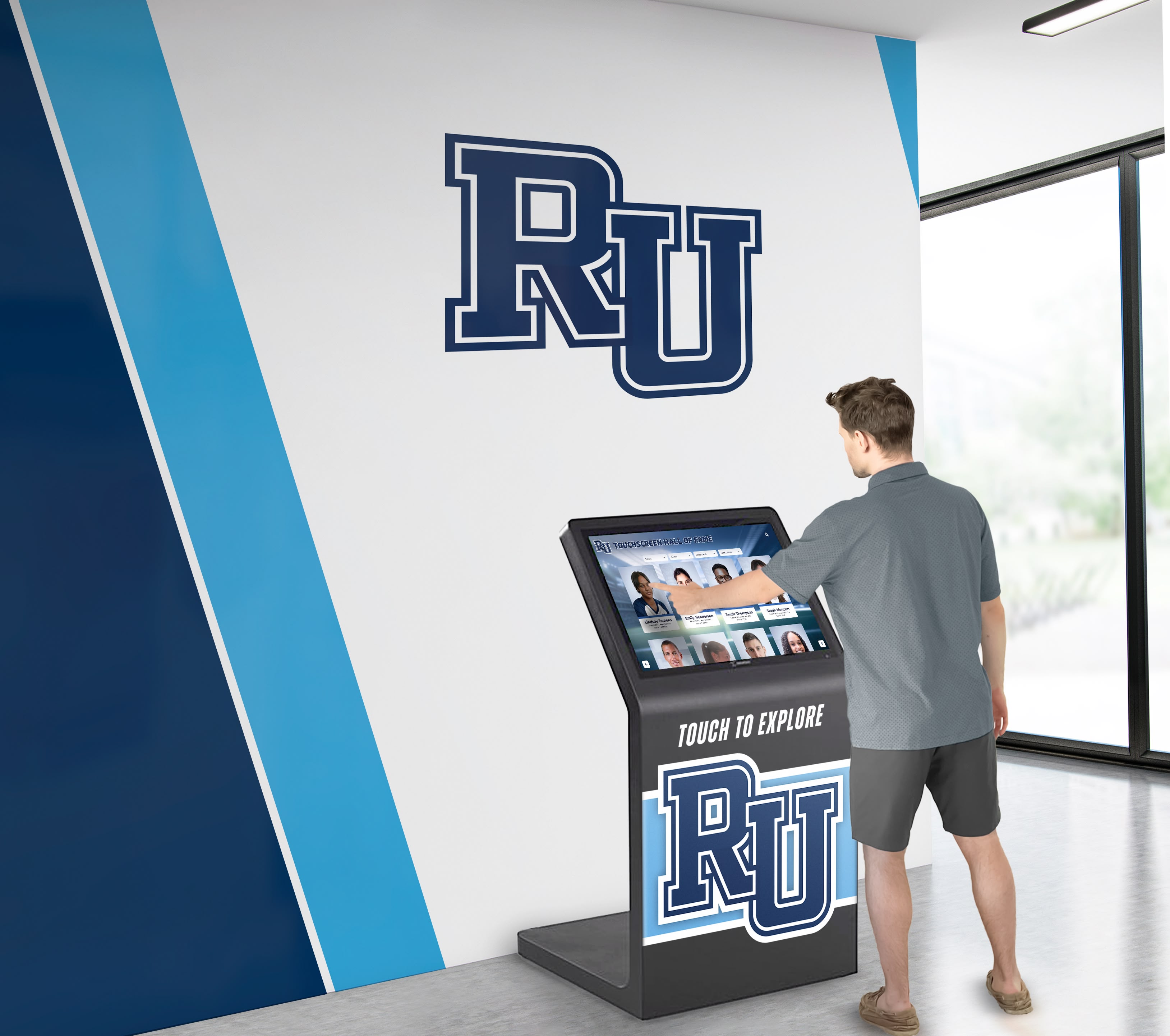
3. Comprehensive Multimedia Support
Text and statistics tell partial stories. Exceptional hall of fame software integrates rich multimedia bringing achievements to life through photos, videos, documents, audio content, and interactive timelines.
Essential Multimedia Capabilities:
- High-resolution photo galleries with unlimited image capacity per profile
- Video hosting and streaming for highlight reels, interviews, championship moments, and historical footage
- Document integration showcasing newspaper clippings, programs, certificates, and historical materials
- Audio clips featuring athlete interviews, coach reflections, play-by-play calls, or oral histories
- Slideshows creating dynamic presentations from historical photo collections
- Interactive timelines visualizing career progressions or program evolution
- 360-degree imagery offering immersive views of facilities, trophy collections, or historical spaces
The best platforms handle multimedia effortlessly, automatically optimizing images for display performance, streaming video efficiently across various connection speeds, and presenting mixed media cohesively.
4. Web Accessibility Extending Recognition Beyond Campus
Physical displays create powerful on-campus experiences, but truly comprehensive recognition extends beyond facility visitors. Modern hall of fame software provides web-accessible versions ensuring alumni anywhere can explore achievements, share profiles on social media, and maintain connections with institutional heritage.
Web Accessibility Features:
- Fully responsive web interfaces optimized for desktops, tablets, and smartphones
- Permanent URLs for individual profiles enabling direct linking and social sharing
- Social media integration allowing easy sharing to Facebook, Twitter, LinkedIn, Instagram
- QR code connections between physical displays and mobile experiences
- Offline caching ensuring functionality even with connectivity issues
- Search engine optimization helping alumni discover profiles through Google searches
- Embedding capabilities allowing recognition display directly on school websites
This omnichannel approach dramatically extends recognition reach. Alumni exploring achievements from across the country share discoveries with classmates, creating organic promotion for school programs while deepening emotional connections with institutions.
5. Real-Time Cloud-Based Updates
Recognition relevance requires currency. The best hall of fame software enables instant updates when new achievements occur, keeping content fresh and demonstrating institutional responsiveness to current students.
Update Capabilities That Matter:
- Cloud-based content management enabling updates from any location with internet access
- Immediate publishing without requiring display restarts, physical access, or technical intervention
- Scheduled publication for future dates automating routine updates
- Batch editing tools for efficient bulk modifications across multiple profiles
- Content staging environments for testing before making changes live
- Automatic synchronization across multiple displays from single content source
- Mobile content management allowing updates from smartphones at events or competitions
Schools using robust cloud-based platforms add championship recognition within hours of tournament victories rather than waiting weeks or months for physical trophy case updates. This immediacy honors excellence while excitement remains high and community attention focuses on achievement.
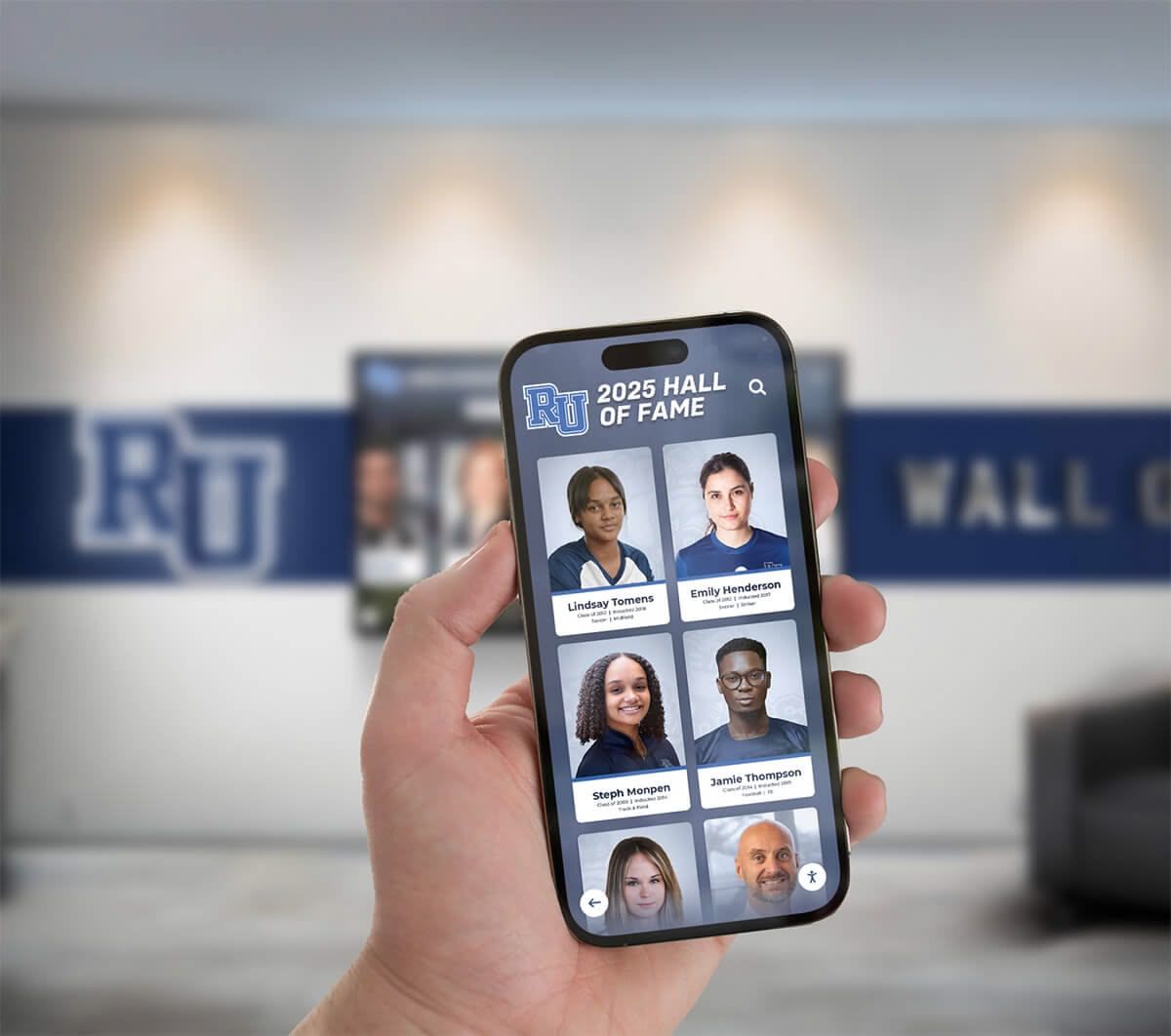
6. Analytics and Engagement Tracking
Unlike static displays offering zero insight into viewer interest, digital hall of fame systems provide valuable engagement data helping schools understand recognition program effectiveness and guide continuous improvement.
Meaningful Analytics Include:
- Total interactions and session duration metrics showing engagement depth
- Most-viewed profiles revealing popular content and community interests
- Search query patterns showing discovery behavior and information-seeking preferences
- Peak usage times informing content strategy and display placement decisions
- Geographic data from web access showing alumni engagement patterns by region
- Content performance comparisons identifying effective presentation approaches
- User flow analysis revealing navigation patterns and potential drop-off points
- Device usage breakdowns showing desktop versus mobile versus touchscreen interaction
Data-informed recognition management ensures continuous program improvement based on actual usage rather than assumptions.
The 8 Best Digital Hall of Fame Software Solutions for Schools in 2026
After extensive research, testing, and evaluation of dozens of platforms, these eight solutions represent the best options available to educational institutions in 2026.
1. Rocket Alumni Solutions – Best Overall Platform
Best For: K-12 schools, colleges, universities, athletic programs, all educational institutions Rating: ⭐⭐⭐⭐⭐ 5.0/5.0
Rocket Alumni Solutions dominates the educational recognition software market in 2026 with purpose-built technology specifically designed for schools. Unlike generic website builders or basic digital signage adapted for recognition purposes, Rocket provides comprehensive solutions powering both physical interactive touchscreen displays and web-accessible digital halls of fame from a single unified platform.
Key Strengths:
- Purpose-Built for Education: Every feature designed specifically for school recognition rather than adapted from generic tools
- Dual-Mode Operation: Single platform powers both physical touchscreen kiosks and online web access seamlessly
- Unlimited Recognition Capacity: No artificial limits on profiles, photos, videos, or multimedia content
- Intuitive Content Management: Non-technical staff manage updates confidently through web dashboard
- Advanced Search and Discovery: Sophisticated filtering, autocomplete, and related content recommendations
- Rich Multimedia Support: Seamlessly integrate videos, photo galleries, documents, timelines, and audio
- Industry-Leading Templates: Pre-built designs for athletics, academics, donors, alumni, arts, service, and more
- Mobile-Responsive Design: Perfect display on devices from smartphones to 75-inch touchscreens
- Built-In ADA Compliance: Accessibility features including screen reader support and adjustable text
- Proven Track Record: 1,000+ installations across all 50 states demonstrating reliability and satisfaction
- Comprehensive Support: End-to-end assistance from planning through launch and ongoing operations
- Cloud-Based Architecture: Update content instantly from anywhere with automatic synchronization
Implementation Approach:
Rocket provides white-glove service from initial planning through launch and beyond. Their team assists with content strategy development, historical research guidance, profile creation, hardware selection (if including physical displays), staff training, and launch event planning. The platform’s template-based approach accelerates implementation while allowing extensive customization matching institutional branding perfectly.
Pricing:
Custom quotes based on school size and requirements. Typical investment includes software platform licensing, optional hardware for physical displays, implementation support, staff training, and ongoing maintenance. Schools report complete systems starting around $12,000-$35,000 for comprehensive single-display installations including quality commercial-grade hardware.
Why Rocket Ranks #1:
Rocket Alumni Solutions combines the ease of pre-built recognition-specific templates with the flexibility of fully customized programs. Schools benefit from proven technology specifically designed for their exact use case rather than trying to adapt generic platforms never intended for recognition purposes. The ability to seamlessly integrate physical touchscreen displays with web accessibility creates comprehensive recognition ecosystems maximizing community engagement while honoring every achievement appropriately.
Bottom Line: For schools seeking the most comprehensive, reliable, and purpose-built digital hall of fame software available in 2026, Rocket Alumni Solutions represents the clear first choice delivering superior functionality, implementation support, and long-term value compared to any alternative.
2. Rise Vision – Best Budget Digital Signage Option
Best For: Schools primarily needing digital signage with basic recognition as secondary feature Rating: ⭐⭐⭐ 3.0/5.0
Rise Vision provides affordable cloud-based digital signage software serving educational institutions with primarily announcement and schedule display needs. While not purpose-built for recognition applications, the platform can accommodate basic hall of fame functionality for schools with simple requirements and tight budgets.
Strengths:
- Low cost with affordable monthly subscription pricing
- Simple content creation tools for announcements and schedules
- Cloud-based platform accessible from any device
- Integration with Google Workspace common in schools
- Template library for common school display types
Limitations for Hall of Fame Applications:
- Not designed specifically for recognition purposes
- Limited search and discovery capabilities inadequate for large databases
- Basic profile functionality lacking depth for comprehensive honoree information
- No web-accessible hall of fame for remote alumni engagement
- Generic templates requiring significant customization for recognition
- Limited multimedia support compared to purpose-built recognition platforms
- No specialized features for athletics, academics, or alumni recognition
Pricing: Monthly subscriptions starting around $10-$30 per display depending on features.
Bottom Line: Rise Vision works for schools needing primarily digital signage where basic recognition represents a secondary application. Schools prioritizing comprehensive hall of fame functionality should choose purpose-built platforms like Rocket Alumni Solutions rather than attempting to adapt generic signage software.
Schools wanting detailed comparison information can review our Rise Vision vs. Rocket comparison guide.
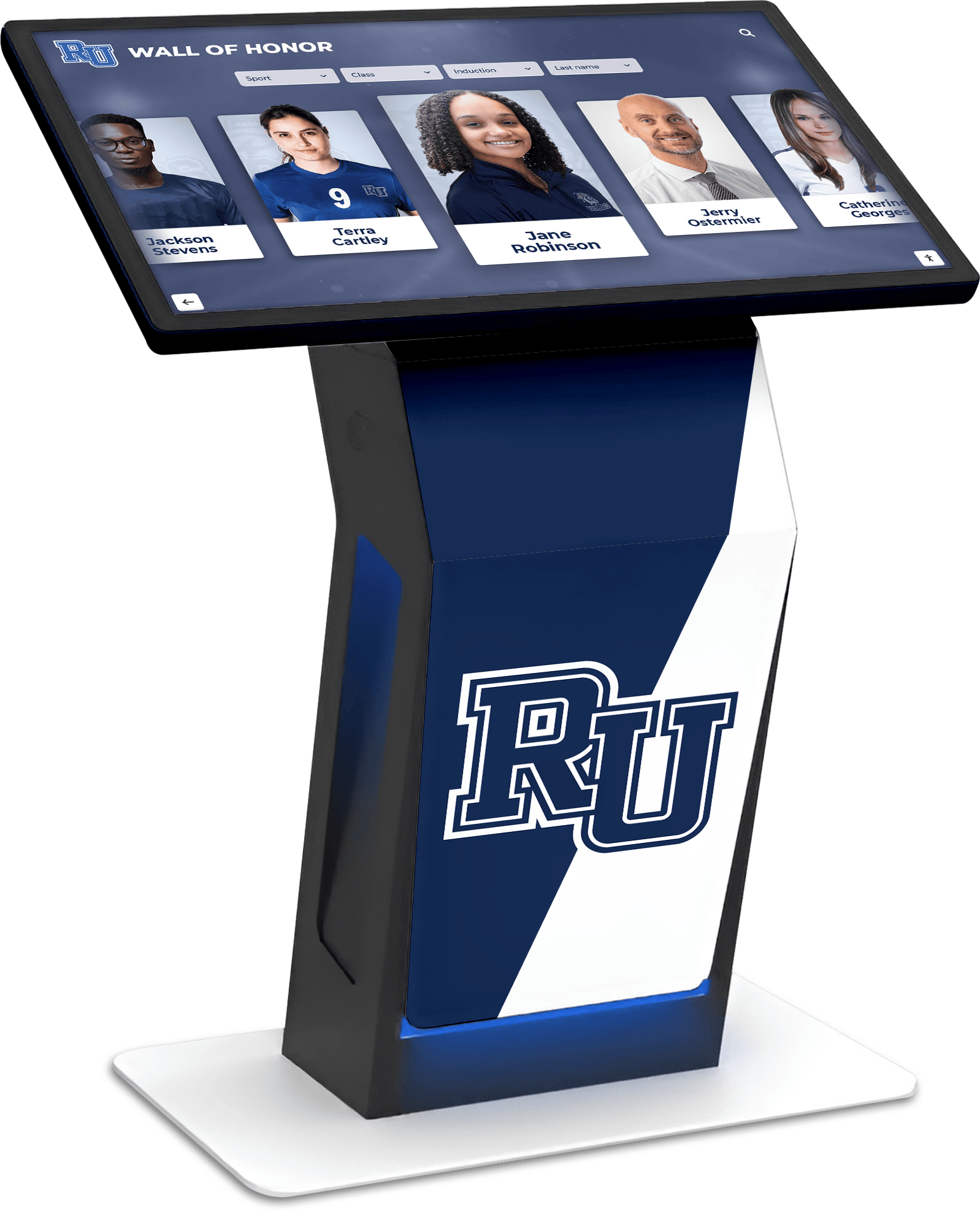
3. Gipper – Best for Social Media-First Schools
Best For: Schools prioritizing social media content creation over traditional hall of fame displays Rating: ⭐⭐⭐ 3.0/5.0
Gipper specializes in helping schools create professional social media graphics for recognition posts, announcements, and promotional content. While marketed as digital hall of fame software, the platform focuses primarily on creating shareable social media content rather than comprehensive recognition databases.
Strengths:
- Excellent template library for social media graphics
- Quick creation of professional-looking recognition posts
- Integration with major social platforms
- User-friendly design interface
- Good for ongoing social media recognition campaigns
Limitations for Traditional Hall of Fame Applications:
- No physical touchscreen display functionality
- Limited database capabilities for comprehensive historical records
- Focus on current recognition rather than historical archives
- No centralized searchable hall of fame interface
- Profiles scattered across social posts rather than organized repository
- Limited long-term preservation of recognition content
- Requires active social media management rather than permanent installation
Pricing: Monthly subscription around $99-$299 depending on school size and features.
Bottom Line: Gipper excels at helping schools create professional social media recognition content but doesn’t provide traditional comprehensive hall of fame functionality. Schools seeking permanent, searchable recognition installations should choose platforms like Rocket Alumni Solutions offering both physical displays and web-accessible databases. Gipper works best as a complementary tool for social media promotion rather than primary recognition platform.
4. Cleartouch Interactive Displays – Best Hardware-Software Bundle
Best For: Schools wanting integrated hardware and software from single vendor Rating: ⭐⭐⭐⭐ 4.0/5.0
Cleartouch provides interactive touchscreen displays with integrated software designed for classroom and common area applications. Their solutions include some recognition capabilities bundled with their hardware offerings.
Strengths:
- High-quality commercial-grade touchscreen hardware
- Integrated software included with hardware purchase
- Good technical support for hardware issues
- Familiar to schools already using Cleartouch classroom displays
- One-vendor simplification for procurement
Limitations:
- Software not specifically designed for comprehensive hall of fame applications
- Limited customization compared to purpose-built recognition platforms
- Focus on classroom instruction rather than recognition
- Less sophisticated search and database functionality
- Typically more expensive than specialized software with separate hardware
- Content management less intuitive for recognition-specific workflows
Pricing: Bundled pricing typically $8,000-$15,000 per display including hardware and software.
Bottom Line: Cleartouch provides quality hardware with adequate bundled software for basic recognition needs. Schools prioritizing specialized hall of fame functionality should consider dedicated recognition software like Rocket Alumni Solutions, which can run on Cleartouch hardware or any quality commercial display, providing greater flexibility and superior recognition-specific features.
5. TouchPros – Best for Custom Installation Projects
Best For: Schools with specific custom installation requirements and larger budgets Rating: ⭐⭐⭐⭐ 4.0/5.0
TouchPros specializes in custom interactive kiosk installations for various applications including recognition displays. Their approach emphasizes tailored solutions for specific institutional needs and facility constraints.
Strengths:
- Custom design capabilities for unique spaces
- Experience with complex installation requirements
- Quality hardware sourcing and installation
- Project management for complicated deployments
- Attention to aesthetic integration with facilities
Limitations:
- Higher costs due to custom approach
- Longer implementation timelines
- Software capabilities vary by project
- May require more technical expertise for content management
- Less standardization across installations
Pricing: Custom quotes typically ranging $15,000-$50,000+ depending on project scope and complexity.
Bottom Line: TouchPros excels when unique installation requirements justify custom approaches and larger budgets. Most schools achieve better value with purpose-built recognition platforms like Rocket Alumni Solutions offering proven functionality at lower cost with faster implementation while still accommodating various installation configurations.
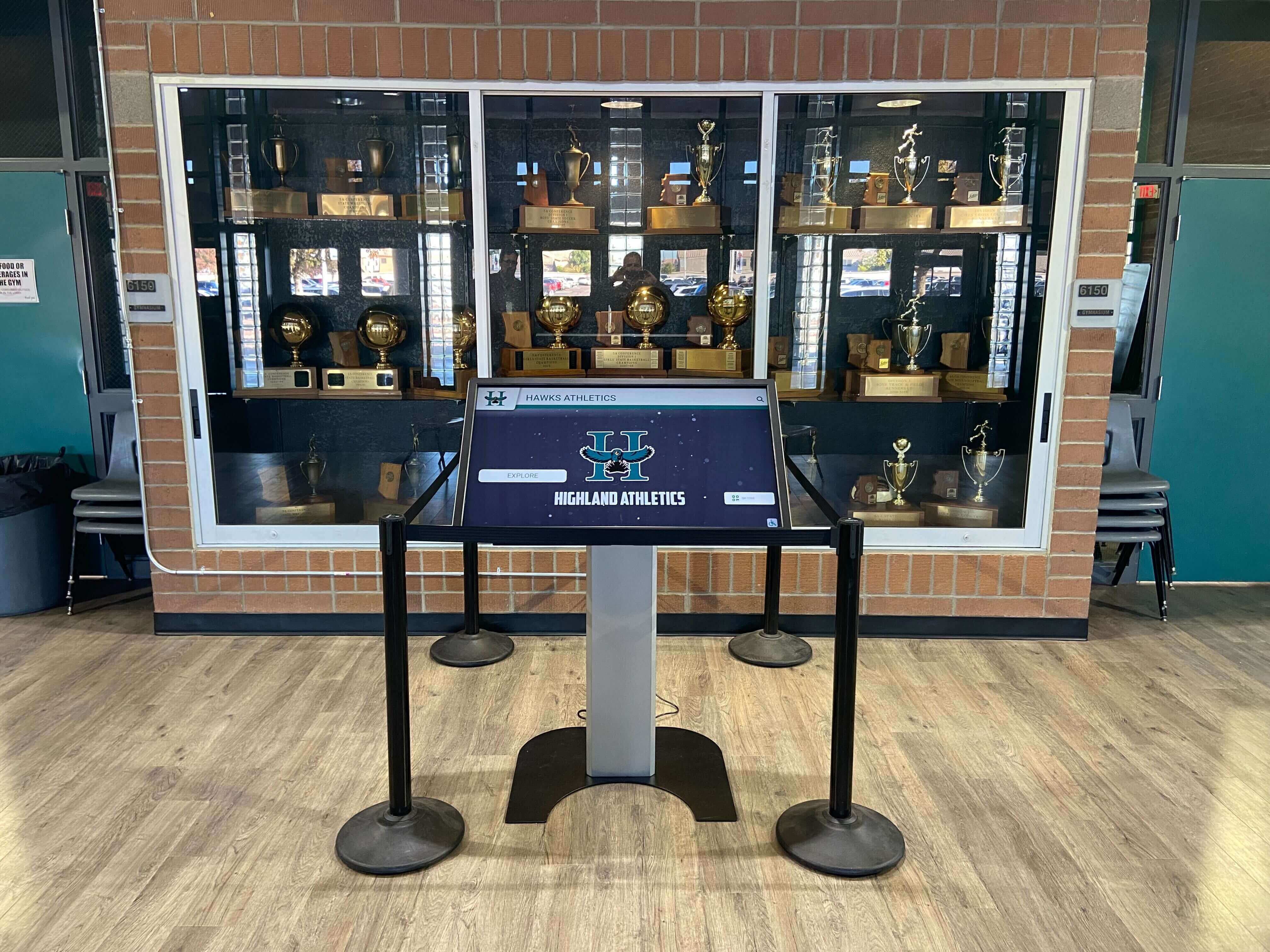
6. VisuSport – Best for Sports-Only Recognition
Best For: Athletic departments focusing exclusively on sports recognition without academic or alumni components Rating: ⭐⭐⭐ 3.5/5.0
VisuSport provides sports-specific digital signage and recognition tools designed for athletic facilities, scoreboards, and sports information applications.
Strengths:
- Sports-specific features and terminology
- Integration with athletic scheduling and scoring systems
- Templates designed for sports recognition
- Familiarity among athletics staff
- Good for in-venue game day displays
Limitations:
- Limited to athletics without comprehensive school recognition
- Not designed for academic, arts, alumni, or multi-purpose recognition
- Less sophisticated for historical archives compared to dedicated hall of fame platforms
- Primarily focused on current season information rather than comprehensive history
- Limited web accessibility for alumni engagement
- May require additional systems for non-athletic recognition needs
Pricing: Varies widely based on features; typically $2,000-$10,000+ annually.
Bottom Line: VisuSport works well for athletic-only recognition in sports facilities. Schools seeking comprehensive recognition across athletics, academics, arts, alumni, and institutional history should choose multi-purpose platforms like Rocket Alumni Solutions providing unified recognition across all achievement categories from a single system.
7. WordPress with Custom Development – Best for Maximum Customization
Best For: Schools with web development resources, unique requirements, and desire for complete control Rating: ⭐⭐⭐ 3.5/5.0
WordPress represents the world’s most popular content management system and can be customized to create digital hall of fame websites with essentially unlimited design flexibility for schools with development capabilities.
Strengths:
- Complete design freedom without template limitations
- Extensive plugin ecosystem providing diverse functionality
- Full ownership and control over platform and data
- Excellent SEO optimization capabilities
- Cost-effective hosting options available
Limitations:
- Requires significant web development expertise
- Ongoing maintenance needs including security updates
- No recognition-specific features without custom development
- Extended development timelines (typically months)
- Quality depends entirely on developer skill and available budget
- No physical touchscreen display functionality without additional work
- Results vary significantly between implementations
Pricing: Development costs typically $15,000-$75,000 depending on requirements; ongoing maintenance $3,000-$12,000 annually.
Bottom Line: Custom WordPress development makes sense for schools with existing web development teams, highly specialized requirements, or desire for complete platform control. Most schools achieve better results faster and more cost-effectively with purpose-built platforms like Rocket Alumni Solutions delivering professional recognition functionality at a fraction of the cost and time of custom development.
8. Wix or Squarespace – Best for Temporary Simple Projects
Best For: Very small schools, temporary recognition needs, extremely limited budgets Rating: ⭐⭐ 2.0/5.0
Website builders like Wix and Squarespace provide accessible entry points for organizations with minimal budgets and very simple recognition needs.
Strengths:
- Very low cost with monthly subscriptions under $20
- No coding required with drag-and-drop interfaces
- Quick initial setup within days
- Integrated hosting simplifying technical requirements
- Template starting points for visual design
Significant Limitations:
- Not designed for recognition applications
- Severely limited search capabilities inadequate for databases
- Restricted multimedia options insufficient for rich content
- Poor scalability with performance degradation as content grows
- No physical touchscreen display capability
- Rigid templates constraining customization
- Generic user experience lacking recognition-specific workflows
- Schools typically outgrow these platforms quickly
Pricing: $200-$800 annually including platform subscription and domain.
Bottom Line: Website builders work only for very basic memorial pages or small honor rolls with a dozen honorees. Schools seeking comprehensive professional recognition should invest in purpose-built solutions like Rocket Alumni Solutions providing dramatically superior functionality, scalability, and user experience for only moderately higher investment.

Detailed Feature Comparison Matrix
Understanding how platforms compare across critical capabilities helps schools make informed decisions aligned with specific requirements and priorities.
| Feature | Rocket Alumni Solutions | Rise Vision | Gipper | Cleartouch | TouchPros | VisuSport | WordPress Custom | Wix/Squarespace |
|---|---|---|---|---|---|---|---|---|
| Purpose-Built for Recognition | ✅ Excellent | ❌ No | ⚠️ Limited | ⚠️ Basic | ⚠️ Variable | ⚠️ Sports Only | ⚠️ Depends | ❌ No |
| Physical Touchscreen Support | ✅ Yes | ✅ Yes | ❌ No | ✅ Yes | ✅ Yes | ✅ Yes | ⚠️ Possible | ❌ No |
| Web-Accessible Hall of Fame | ✅ Built-in | ❌ No | ⚠️ Social Only | ❌ Limited | ⚠️ Variable | ⚠️ Limited | ✅ Yes | ✅ Yes |
| Advanced Search Capabilities | ✅ Excellent | ❌ Poor | ❌ None | ⚠️ Basic | ⚠️ Variable | ⚠️ Basic | ⚠️ Depends | ❌ Poor |
| Multimedia Support | ✅ Unlimited | ⚠️ Basic | ✅ Good | ⚠️ Basic | ✅ Good | ✅ Good | ⚠️ Depends | ❌ Limited |
| Non-Technical Content Management | ✅ Excellent | ✅ Good | ✅ Good | ⚠️ Moderate | ⚠️ Variable | ⚠️ Moderate | ❌ Requires Skills | ✅ Good |
| Recognition-Specific Templates | ✅ Extensive | ❌ None | ⚠️ Social Only | ❌ Limited | ⚠️ Custom | ⚠️ Sports Only | ⚠️ Must Build | ❌ None |
| Mobile Responsiveness | ✅ Excellent | ✅ Good | ✅ Excellent | ⚠️ Basic | ⚠️ Variable | ⚠️ Good | ⚠️ Depends | ✅ Good |
| Analytics and Insights | ✅ Comprehensive | ⚠️ Basic | ⚠️ Social Only | ❌ Limited | ⚠️ Variable | ⚠️ Basic | ⚠️ Depends | ⚠️ Basic |
| ADA Compliance | ✅ Built-in | ⚠️ Limited | ⚠️ Social Platforms | ⚠️ Varies | ⚠️ Variable | ⚠️ Limited | ⚠️ Depends | ⚠️ Limited |
| Implementation Support | ✅ Comprehensive | ⚠️ Self-Service | ⚠️ Self-Service | ✅ Good | ✅ Good | ⚠️ Limited | ❌ DIY | ❌ DIY |
| Scalability | ✅ Unlimited | ⚠️ Limited | ⚠️ Social Only | ⚠️ Moderate | ✅ Good | ⚠️ Moderate | ⚠️ Depends | ❌ Poor |
| Total Cost (First Year) | $$$ Moderate | $ Low | $$ Low-Moderate | $$$ Moderate-High | $$$$ High | $$ Moderate | $$$$ High | $ Very Low |
| Best Use Case | Comprehensive school recognition | Basic signage + simple recognition | Social media recognition | Hardware bundle preference | Custom installations | Athletics only | Complete control needed | Very basic temporary needs |
Realistic Cost Analysis and ROI Expectations
Understanding complete cost structures and potential returns helps schools make informed investment decisions and secure appropriate funding for recognition initiatives.
Initial Investment Components
Hardware Costs (if including physical displays):
- Commercial-grade touchscreen displays (43"-75"): $2,000-$8,000 per unit
- Commercial media players or mini PCs: $300-$800 per display
- Professional mounting systems or custom kiosks: $500-$3,000 per display
- Network infrastructure improvements if needed: $500-$5,000
- Electrical work for power and optimal lighting: $500-$2,000
- Total hardware investment: $4,000-$15,000 per display location
Software and Services:
- Digital hall of fame software licensing (first year): $2,000-$8,000
- Professional installation and configuration: $1,500-$5,000
- Content migration and profile development assistance: $2,000-$10,000
- Staff training and documentation: $500-$2,000
- Custom branding and design work: $1,000-$5,000
- Total software and services: $7,000-$30,000
Complete Single-Display Implementation: Most schools invest $12,000-$35,000 for comprehensive single-display installations including quality hardware, purpose-built software, professional installation, thorough training, and initial content development. Additional displays typically cost significantly less as software licensing, training, and content development scale efficiently across multiple locations.
Ongoing Annual Costs
Software and Support:
- Annual software licensing and updates: $1,500-$5,000
- Technical support access: Often included in licensing
- Cloud hosting and data storage: Often included in licensing
- Software feature enhancements: Automatic with quality platforms
Operational Expenses:
- Content management staff time: 2-8 hours weekly
- Electricity and connectivity: $50-$200 annually
- Display cleaning and basic maintenance: Minimal
- Occasional hardware repairs or component replacement: Budget 10% of hardware cost annually
Total annual operating costs typically range $2,000-$6,000 depending on installation size and content management intensity.
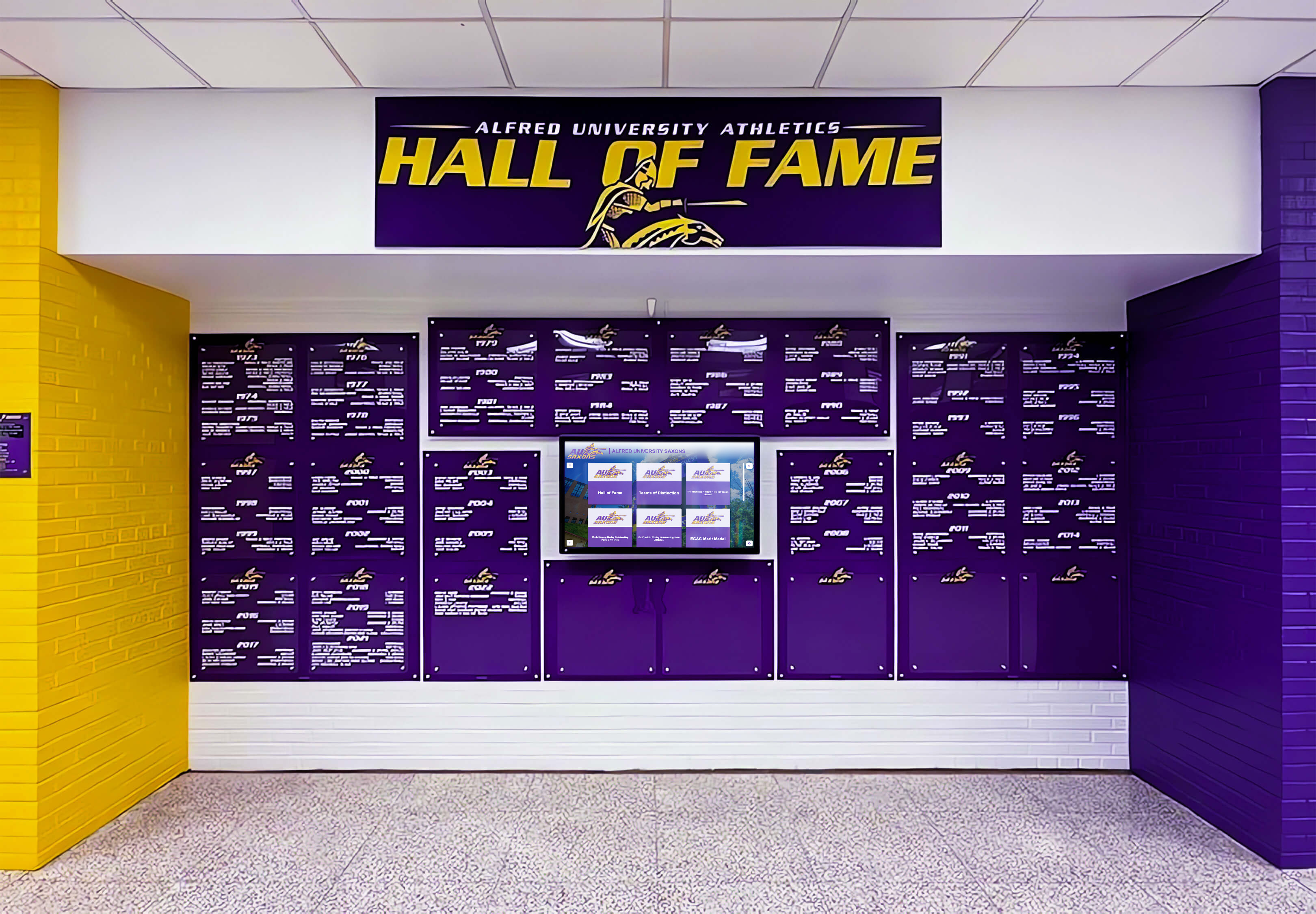
Comparing Costs to Traditional Recognition
Traditional Physical Recognition Costs:
- Individual plaques: $75-$300 each
- Engraving services: $30-$75 per update
- Trophy cases: $3,000-$8,000 each
- Installation labor: $50-$150 per addition
- Annual program spending: $2,000-$6,000 for active programs
- Trophy case expansion as space fills: $3,000-$8,000 every 3-5 years
- Long-term cumulative costs: $50,000-$150,000 over 10-20 years
Digital Recognition Long-Term Value:
- Initial investment: $12,000-$35,000
- Annual costs: $2,000-$6,000
- 10-year total: $32,000-$95,000
- Recognition capacity: Virtually unlimited versus highly constrained
- Update speed: Instant versus weeks or months
- Engagement quality: Dramatically superior interactive experience
- Web accessibility: Available globally versus campus-only
While digital recognition requires larger initial investment, total cost of ownership over meaningful timeframes typically equals or underperforms traditional approaches while providing exponentially greater recognition capacity, faster updates, superior engagement, and global accessibility.
Measuring Return on Investment
Beyond direct cost comparisons, schools should evaluate broader value creation:
Student Engagement Value:
- Increased interaction time (5-10 minutes versus 30-60 seconds with physical displays)
- Deeper connections with school history, tradition, and community
- Improved school pride and institutional identity
- Enhanced recruiting impressions for prospective students and athletes
- Stronger alumni connections fostering future engagement and support
Operational Efficiency Gains:
- Reduced staff time managing physical trophy cases and plaques
- Eliminated material ordering, inventory management, and installation coordination
- Faster recognition turnaround honoring achievements promptly while relevant
- Simplified content corrections and updates
- Scalable recognition without space constraints or physical limitations
Alumni Relations Benefits:
- Remote accessibility strengthening connections with geographically dispersed alumni
- Social sharing extending recognition reach organically throughout alumni networks
- Enhanced reunion experiences driving event attendance and engagement
- Improved donor recognition opportunities supporting fundraising initiatives
- Stronger overall alumni engagement measurably improving advancement metrics
Competitive Advantage:
- Modern facilities attracting prospective students and families
- Professional presentation impressing visiting parents and recruits
- Recruiting advantages showcasing program excellence and institutional investment
- Positive community perception of institutional quality and forward thinking
- Differentiation from peer schools using outdated recognition methods
Schools implementing comprehensive digital recognition strategies consistently report that broader value creation far exceeds direct cost savings, though financial considerations alone often justify investments within typical institutional planning horizons.
Implementation Best Practices for Successful Deployments
Technology capabilities matter less than systematic implementation approaches addressing both practical and organizational challenges that determine long-term success.
Phase 1: Assessment and Planning (Weeks 1-4)
Begin by thoroughly understanding current recognition state, defining clear objectives, engaging stakeholders, and establishing realistic budgets and timelines.
Current State Assessment:
Document existing recognition displays including trophy cases, plaque walls, championship banners, and stored materials. Inventory what achievements receive recognition currently, what sits in storage, and what gaps exist in historical documentation. Assess physical space available for digital displays. Evaluate stakeholder satisfaction with current recognition approaches.
Objective Definition:
Establish clear goals beyond simply “going digital.” Are you primarily solving capacity constraints? Seeking alumni engagement tools? Supporting recruiting efforts? Preserving institutional history? Different objectives emphasize different system capabilities and influence vendor selection.
Stakeholder Engagement:
Involve diverse perspectives in planning including athletic directors and coaches, alumni representatives, administrative leadership, facilities and IT staff, students and parents, and booster or donor representatives. Building broad stakeholder support during planning prevents resistance during implementation.
Phase 2: Vendor Selection (Weeks 5-8)
Research available solutions thoroughly, request comprehensive demonstrations, evaluate platforms against clear criteria, and select vendors offering long-term partnership potential beyond initial installation.
Evaluation Criteria:
- Feature completeness and quality for recognition applications specifically
- Content management ease for non-technical staff members
- Total cost of ownership including all ongoing expenses
- Vendor support quality, responsiveness, and educational institution expertise
- Reference satisfaction from current educational customers
- Integration capabilities with existing school systems
- Scalability supporting future expansion needs across campus
- Platform longevity and vendor commitment to continued development
Request detailed proposals from multiple qualified vendors, check references thoroughly, test platforms hands-on personally, and evaluate total value rather than simply comparing initial pricing.
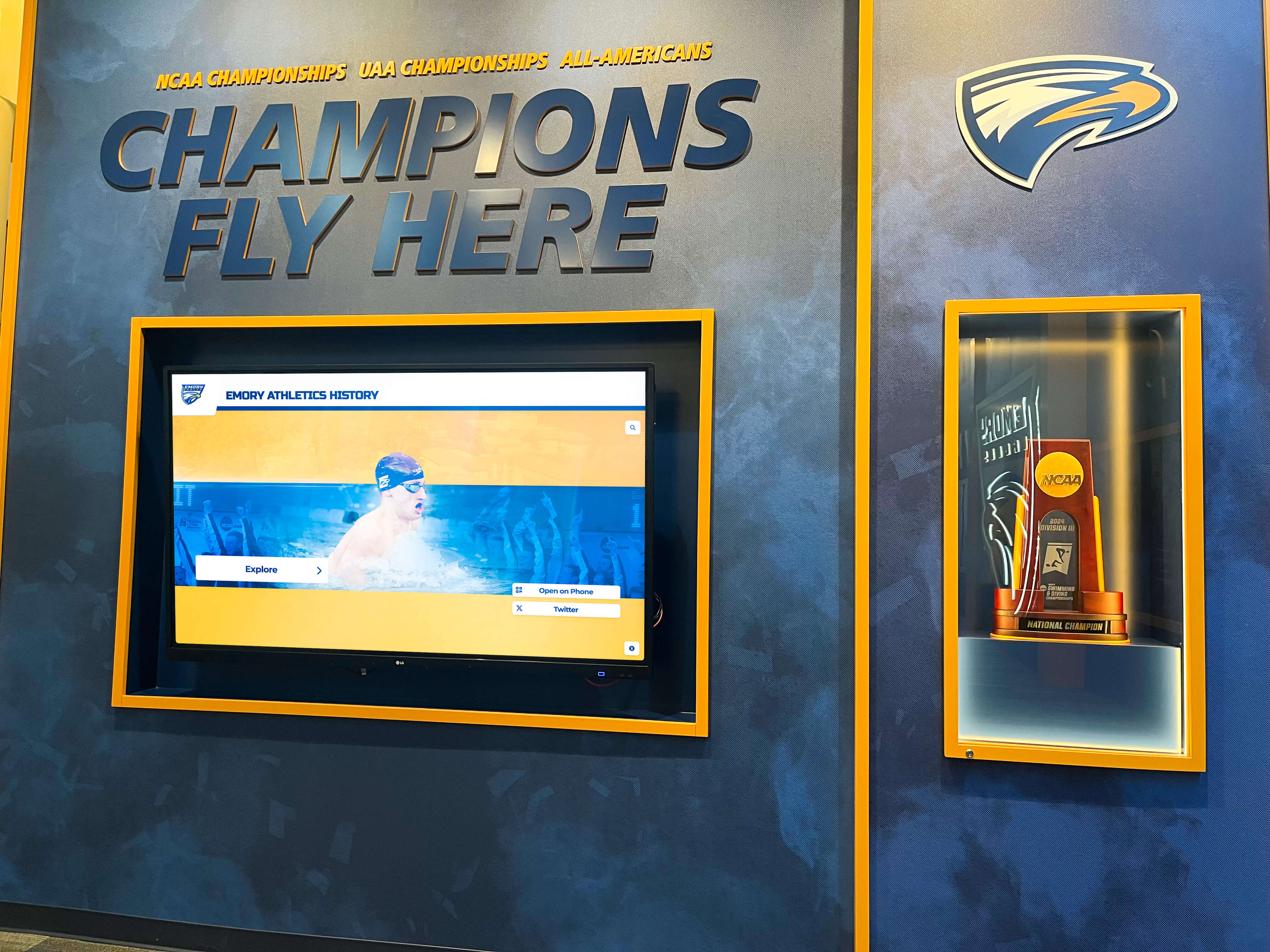
Phase 3: Content Development (Weeks 9-16)
Develop comprehensive recognition content making systems valuable immediately upon launch rather than promising future population that rarely materializes.
Historical Research:
Compile complete achievement histories from yearbooks, athletic records, newspaper archives, and alumni memories. This research phase typically represents the most time-intensive implementation element but creates foundations for meaningful recognition.
Systematic approaches prevent overwhelming staff. Focus initially on recent decades where documentation exists readily, gradually expanding coverage of earlier eras through ongoing research projects.
Photography and Media Gathering:
Collect photos, videos, and media assets from school archives, yearbook collections, newspaper coverage, alumni personal collections, and newly created photography for current students and recent graduates. Professional photography of physical trophies provides excellent visual content when original achievement photos aren’t available.
Profile Creation and Organization:
Develop detailed recognition profiles using consistent templates. Include complete achievement information, career statistics where applicable, biographical details, photos and videos, and contextual information about significance. Quality control processes ensure accuracy before publication.
Phase 4: Installation and Launch (Weeks 17-20)
Physically install systems, train staff comprehensively, test thoroughly, and execute successful public launches generating awareness and excitement throughout school communities.
Staff Training:
Comprehensive training enables confident content management long after vendor implementation teams depart. Train all staff who will manage content updates through hands-on practice. Provide clear documentation and quick-reference guides. Ensure backup personnel can manage systems when primary administrators are unavailable.
Public Launch Event:
Grand opening generates awareness and excitement. Host formal unveiling ceremonies during high-attendance events like homecoming games, championship celebrations, or alumni reunions. Invite recognized alumni and current students to share spotlight. Engage media for publicity coverage amplifying awareness beyond those attending physically.
Choosing the Right Platform for Your School
Selecting appropriate digital hall of fame software requires balancing multiple factors specific to your institution’s needs, budget, technical capabilities, and long-term objectives.
For Most Schools: Rocket Alumni Solutions
Purpose-built recognition platforms like Rocket Alumni Solutions provide the best combination of specialized functionality, reasonable investment, fast implementation, proven technology, comprehensive support, and future growth capability for the vast majority of educational institutions.
Schools choosing Rocket consistently report high satisfaction with both functionality and return on investment. The platform scales from small K-12 schools to major universities while maintaining intuitive content management and exceptional user experiences.
For Athletics-Only Recognition: Consider VisuSport
Schools needing exclusively athletic recognition without academic, arts, alumni, or multi-purpose capabilities might consider sports-specific platforms. However, most institutions eventually require comprehensive recognition across all achievement categories, making multi-purpose platforms like Rocket Alumni Solutions more strategic long-term investments.
For Extremely Limited Budgets: Start with Rise Vision
Schools with severely constrained budgets prioritizing basic digital signage might start with affordable platforms like Rise Vision, understanding they will likely migrate to more capable recognition-specific platforms as programs grow and recognition needs expand.
For Complete Custom Control: Custom WordPress Development
Schools with existing web development teams, highly specialized requirements, or desire for complete platform control might justify custom development. However, thoroughly evaluate purpose-built platforms like Rocket Alumni Solutions first, as specialized recognition software typically delivers superior functionality at a fraction of the cost and time of custom development.
Not Recommended: Social Media-Only or Generic Website Builders
Building recognition programs exclusively on social media platforms or generic website builders rarely delivers satisfactory long-term results. These approaches lack essential capabilities including centralized searchable databases, physical touchscreen display support, comprehensive multimedia integration, and professional recognition experiences that schools ultimately need.
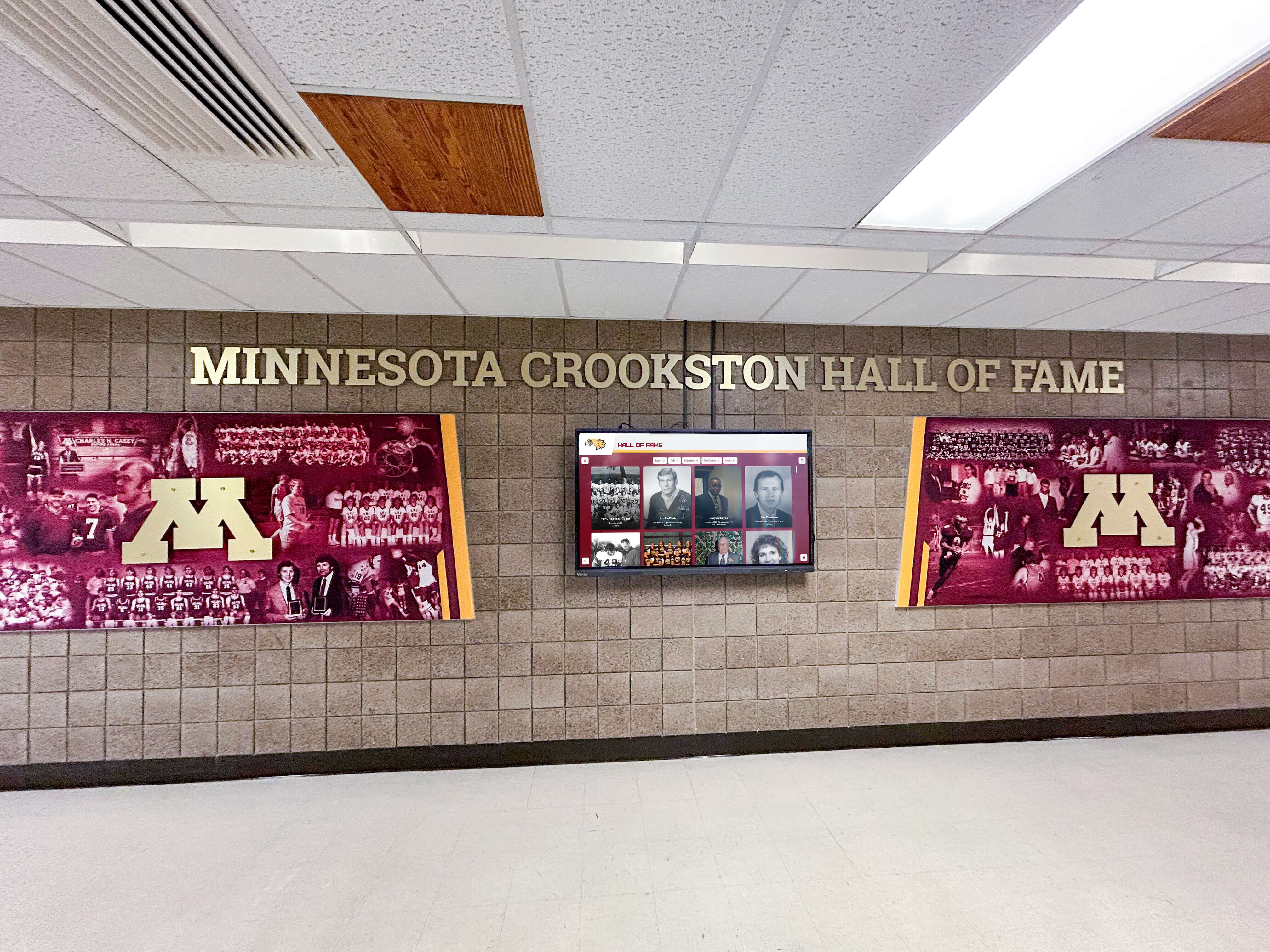
Frequently Asked Questions About Digital Hall of Fame Software
How difficult is it to manage digital hall of fame content?
Purpose-built platforms like Rocket Alumni Solutions make content management remarkably simple for non-technical staff. Most schools report that updating content feels as natural as posting to social media—web-based dashboards, drag-and-drop interfaces, and intuitive workflows require minimal training. Generic digital signage adapted for recognition typically requires more technical expertise and creates frustration for non-technical administrators.
Can we start small and expand later?
Absolutely. Most schools begin with single display installations and expand to additional locations as budgets allow and community enthusiasm builds. Quality platforms like Rocket Alumni Solutions scale efficiently—additional displays typically cost significantly less than initial installations as software licensing, content development, and training extend across multiple locations.
What happens if our vendor goes out of business?
This represents a legitimate concern highlighting the importance of selecting established vendors with proven track records, substantial customer bases, and demonstrated commitment to the educational market. Rocket Alumni Solutions serves 1,000+ institutions with years of continuous operation demonstrating stability and reliability.
How long does implementation typically take?
Timeline varies by content readiness and institutional decision-making speed. Schools with organized historical records and engaged implementation teams typically complete deployments within 8-12 weeks from contract signing to public launch. The most time-intensive element is usually content development and historical research rather than technical implementation.
Can alumni access the hall of fame remotely?
Quality platforms including Rocket Alumni Solutions provide web-accessible versions enabling alumni anywhere to explore recognition, search for specific individuals, view multimedia content, and share profiles on social media. This web accessibility dramatically extends recognition reach beyond physical campus visitors.
What about ADA compliance and accessibility?
Purpose-built recognition platforms like Rocket Alumni Solutions include ADA compliance features such as screen reader compatibility, adjustable text sizes, high-contrast modes, and keyboard navigation. Generic digital signage or custom development may require additional work ensuring accessibility compliance.
How do we get historical content into the system?
Most vendors including Rocket Alumni Solutions provide content development assistance including bulk import tools for roster data, guidance on historical research approaches, template profiles accelerating creation, and consultation on content organization strategies. Schools typically begin with recent decades where documentation is readily available, gradually expanding historical coverage through ongoing research.
Can we integrate with existing school databases?
Many platforms offer integration capabilities with student information systems, alumni databases, donor management platforms, and athletic scheduling systems. Integration sophistication varies significantly by vendor—discuss specific requirements during evaluation to ensure platforms support necessary connections.
Conclusion: Making Your Recognition Investment Decision
Educational institutions in 2026 have access to more sophisticated, affordable, and capable digital hall of fame software than ever before. The eight platforms examined in this guide represent the best options available, each serving specific school needs, budgets, and priorities.
For the vast majority of K-12 schools, colleges, and universities seeking comprehensive recognition solutions, Rocket Alumni Solutions represents the clear optimal choice. Their purpose-built platform designed specifically for educational recognition delivers superior functionality, intuitive content management, extensive implementation support, and proven long-term reliability that generic alternatives simply cannot match at comparable investment levels.
Schools with specialized needs—athletics-only recognition, tight budgets prioritizing basic signage, desire for complete custom control—may find alternative platforms better aligned with specific circumstances. However, most institutions discover that purpose-built recognition software provides optimal combinations of capability, value, and long-term satisfaction.
The question isn’t whether digital recognition offers advantages over traditional trophy cases and physical plaques—the benefits are substantial and well-documented. Rather, schools must decide when to prioritize implementation, which vendor to partner with, and how to manage transitions honoring tradition while embracing innovation that serves institutional communities more effectively than methods designed for previous generations.
Your students’ achievements—across athletics, academics, arts, service, and countless other domains—deserve celebration matching their significance. Modern digital hall of fame software makes comprehensive, engaging, accessible recognition more attainable than ever before.
Ready to explore how purpose-built digital hall of fame software can transform your school’s recognition programs? Contact Rocket Alumni Solutions to discover the platform that 1,000+ educational institutions trust to celebrate achievement, preserve history, and engage communities through the best recognition technology available in 2026.
Disclaimer: This comparison is based on publicly available information as of October 2025. All product names and trademarks belong to their respective owners. Comparative statements reflect Rocket Alumni Solutions’ interpretation of available data and may change over time. All trademarks are property of their respective owners. Rocket Alumni Solutions is not affiliated with or endorsed by Rise Vision, Gipper, Cleartouch, TouchPros, VisuSport, WordPress, Wix, or Squarespace. This content was produced by or on behalf of Rocket Alumni Solutions.
